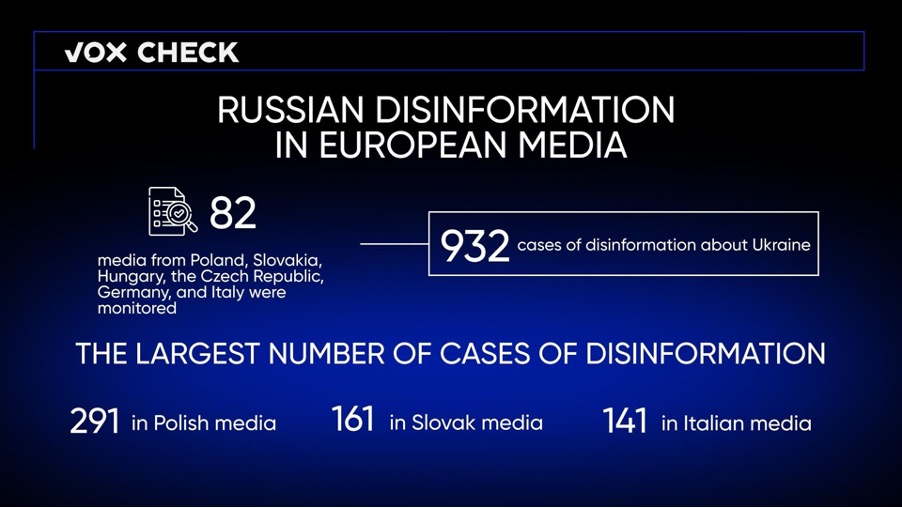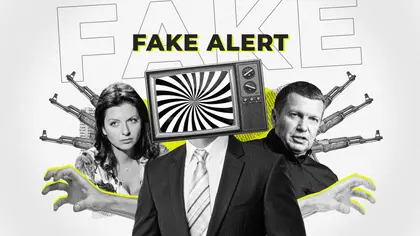During April, there were 932 individual cases of Russian fakes and propaganda in European media outlets, according to an independent monitoring group.
The total of 932 disinformation cases identified by VoxUkraine, an independent analytical and fact-checking platform, represents more than 30 per day across the 85 monitored outlets from Poland, Slovakia, Hungary, the Czech Republic, Italy, and Germany.
JOIN US ON TELEGRAM
Follow our coverage of the war on the @Kyivpost_official.
Cases monitored in April were 1.6 percent more than in March (with 917 individual cases) which suggests consistency and discipline in Russia’s propaganda strategy.
In its monthly report, VoxUkraine found that the largest number of disinformation cases were again in Poland (291) followed by media in Slovakia (161) and Italy (141).

Poland and Slovakia are the only countries that have donated serviceable fighter jets to Ukraine so far. Poland has provided more tanks to Ukraine than any other country, but it is currently entering an election period where isolationist elements seem to be gaining ground.
Italy is experiencing pro-Ukrainian politics under the leadership of Prime Minister Georgia Meloni, as highlighted by Ukrainian President Volodymyr Zelensky's visit to Rome earlier this week.
VoxUkraine said that, during April, the false narratives most actively promoted in European media outlets were about: Western control over Ukraine, the illegitimacy of the Ukrainian government, justifications of Russian aggression, and accusations of Nazism and terrorism in Ukraine.

Putin Signs Law Letting Ukraine Fighters Write Off Bad Debts
Propaganda in Poland
In Poland, the most widely promoted narratives were about Nazism in Ukraine (39 cases), Western control over Ukraine (37 cases), and the impact of Ukrainian refugees (30 cases).
The latter seems especially targeted to Poland, given it has accepted some 1.5 million Ukrainians as refugees since the start of Russia’s full-scale invasion, with many more millions transiting through Poland.
“Since Poland has hosted the largest number of Ukrainian refugees, disinformation about refugees is often most widespread in Polish media,” VoxUkraine’s report said.
“[The disinformation] claimed that most Ukrainian refugees come from western and central regions of Ukraine, which allegedly did not feel the effects of the war and have enough resources to provide for their own population. Refugees were also referred to privileged individuals who abuse the help of EU countries and hinder Poland from taking care of its own citizens… Refugees are demonized: they are called Nazis, criminals, and terrorists who cross EU borders without any obstacles,” according to VoxUkraine.
Propaganda in Slovakia
As a result of monitoring 13 Slovakian media outlets, VoxUkraine found 161 cases of disinformation. Narratives about the discrediting of the Ukrainian government (20 cases), Western control over Ukraine (16 cases), and war crimes allegedly committed by Ukraine (12 cases) were the most widespread.
VoxUkraine assessed that “as in previous months [in the Slovakian media], the main target of discreditation was the President of Ukraine. According to propagandists in Slovak media, a popular uprising against the President will soon begin due to the continuation of the war and the decline in living standards… Fabricated news is also used, such as an alleged ‘cartoon by French animators’ in which Zelensky [is presented as] a drug addict, a puppet, and a corrupt official.”
VoxUkraine contends that such narratives are perpetuated by both the broadcasting of both old and new items of fake news, as well as the repetition of false statements initially made by Russian outlets, commentators, official spokespersons and social media content generators.
Some of the outlets monitored appear to be openly pro-Kremlin and are directly involved in disinformation; others are considered mainstream.
You can also highlight the text and press Ctrl + Enter






